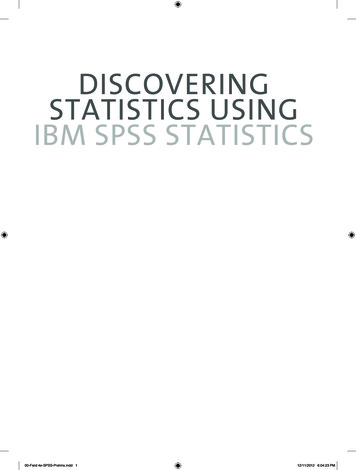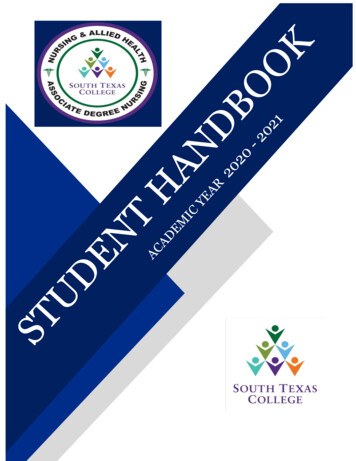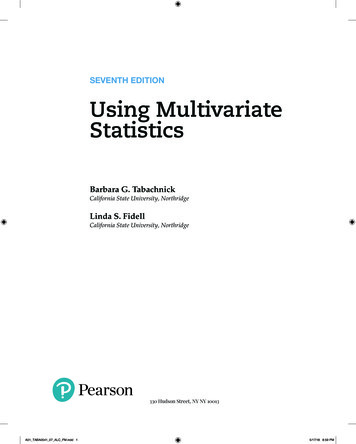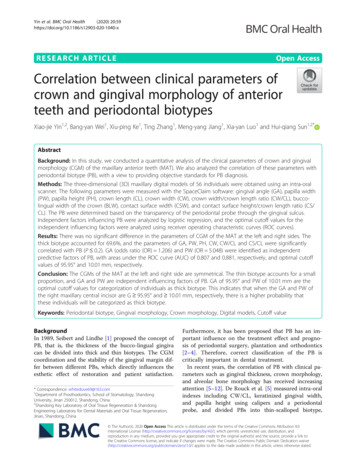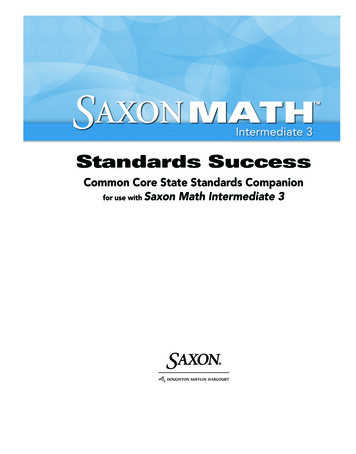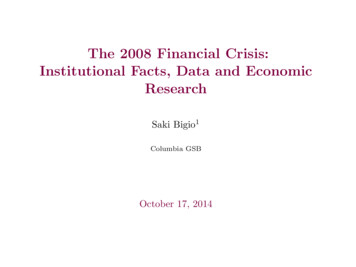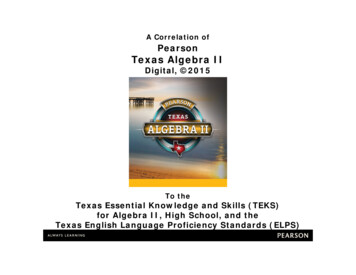
Transcription
A Correlation ofPearsonTexas Algebra IIDigital, 2015To theTexas Essential Knowledge and Skills (TEKS)for Algebra II, High School, and theTexas English Language Proficiency Standards (ELPS)
Chapter 111. Mathematics§111.40. Algebra II, Adopted 2012 (One-Half to One Credit).Proclamation 2015Correlations to the Texas Essential Knowledge and Skills (TEKS): Student MaterialSubjectChapter 111. MathematicsSubchapterSubchapter C. High SchoolCourse§111.40. Algebra II, Adopted 2012 (One-Half to One Credit).PublisherPearson Education, Inc., publishing as Prentice HallProgram TitlePearson Texas Algebra 2, DigitalProgram ISBN9780133306873(a) General requirements. Students shall be awarded one-half to one credit for successful completion of this course. Prerequisite: Algebra I.(b) Introduction.(1) The desire to achieve educational excellence is the driving force behind the Texas essential knowledge and skills for mathematics, guided by the college and career readiness standards. By embedding statistics, probability, and finance, whilefocusing on fluency and solid understanding, Texas will lead the way in mathematics education and prepare all Texas students for the challenges they will face in the 21st century.(2) The process standards describe ways in which students are expected to engage in the content. The placement of the process standards at the beginning of the knowledge and skills listed for each grade and course is intentional. The processstandards weave the other knowledge and skills together so that students may be successful problem solvers and use mathematics efficiently and effectively in daily life. The process standards are integrated at every grade level and course. Whenpossible, students will apply mathematics to problems arising in everyday life, society, and the workplace. Students will use a problem-solving model that incorporates analyzing given information, formulating a plan or strategy, determining a solution,justifying the solution, and evaluating the problem-solving process and the reasonableness of the solution. Students will select appropriate tools such as real objects, manipulatives, paper and pencil, and technology and techniques such as mentalmath, estimation, and number sense to solve problems. Students will effectively communicate mathematical ideas, reasoning, and their implications using multiple representations such as symbols, diagrams, graphs, and language. Students will usemathematical relationships to generate solutions and make connections and predictions. Students will analyze mathematical relationships to connect and communicate mathematical ideas. Students will display, explain, or justify mathematical ideasand arguments using precise mathematical language in written or oral communication.(3) In Algebra II, students will build on the knowledge and skills for mathematics in Kindergarten-Grade 8 and Algebra I. Students will broaden their knowledge of quadratic functions, exponential functions, and systems of equations. Students will studylogarithmic, square root, cubic, cube root, absolute value, rational functions, and their related equations. Students will connect functions to their inverses and associated equations and solutions in both mathematical and real-world situations. Inaddition, students will extend their knowledge of data analysis and numeric and algebraic methods.(4) Statements that contain the word "including" reference content that must be mastered, while those containing the phrase "such as" are intended as possible illustrative examples.(c) Knowledge and Skills.Page 1 of 255Pearson Education, Inc., publishing as Prentice Hall: 9780133306873Student Material
Chapter 111. Mathematics§111.40. Algebra II, Adopted 2012 (One-Half to One Credit).Knowledge and Skills StatementStudent ExpectationBreakout(1) Mathematical process standards. The studentuses mathematical processes to acquire anddemonstrate mathematical understanding. Thestudent is expected to:(A) apply mathematics toproblems arising in everydaylife, society, and theworkplace(i) apply mathematics toproblems arising in everydaylife(1) Mathematical process standards. The studentuses mathematical processes to acquire anddemonstrate mathematical understanding. Thestudent is expected to:(1) Mathematical process standards. The studentuses mathematical processes to acquire anddemonstrate mathematical understanding. Thestudent is expected to:Page 2 of 255(A) apply mathematics toproblems arising in everydaylife, society, and theworkplace(A) apply mathematics toproblems arising in everydaylife, society, and theworkplaceProclamation 2015Citation TypeComponent ment9780133306873Instruction9780133306873Page (s)Specific Location18 Lesson 1–3 Prob. 419–20Lesson 1–3 Exs. 7, 2715 Lesson 1–3 Prob. 4 Got It142 Lesson 4–4 Prob. 4115 Lesson 4–4 Prob. 4 Got It(ii) apply mathematics toproblems arising in society(iii) apply mathematics toproblems arising in 306873Pearson Education, Inc., publishing as Prentice Hall: 978013330687372 Lesson 3–1 Prob. 37661173176Ex. 26Prob. 3 Got ItLesson 5–4 Prob. 3Lesson 5–4 Exs. 38Lesson 3–1Lesson 3–199 Lesson 3–5 Prob. 410085191200Lesson 3–5 Ex. 10Lesson 3–5 Prob. 4 Got ItLesson 5–7 Prob. 2Lesson 5–8 Ex. 8Student Material
Chapter 111. Mathematics§111.40. Algebra II, Adopted 2012 (One-Half to One Credit).Knowledge and Skills StatementStudent ExpectationBreakout(1) Mathematical process standards. The studentuses mathematical processes to acquire anddemonstrate mathematical understanding. Thestudent is expected to:(B) use a problem-solvingmodel that incorporatesanalyzing given information,formulating a plan orstrategy, determining asolution, justifying thesolution, and evaluating theproblem-solving process andthe reasonableness of thesolution(i) use a problem-solvingmodel that incorporatesanalyzing given information,formulating a plan orstrategy, determining asolution, justifying thesolution, and evaluating theproblem-solving process(1) Mathematical process standards. The studentuses mathematical processes to acquire anddemonstrate mathematical understanding. Thestudent is expected to:(1) Mathematical process standards. The studentuses mathematical processes to acquire anddemonstrate mathematical understanding. Thestudent is expected to:Page 3 of 255(B) use a problem-solvingmodel that incorporatesanalyzing given information,formulating a plan orstrategy, determining asolution, justifying thesolution, and evaluating theproblem-solving process andthe reasonableness of thesolution(C) select tools, includingreal objects, manipulatives,paper and pencil, andtechnology as appropriate,and techniques, includingmental math, estimation, andnumber sense asappropriate, to solveproblems(ii) use a problem-solvingmodel that incorporatesanalyzing given information,formulating a plan orstrategy, determining asolution, justifying thesolution, and evaluating thereasonableness of thesolutionProclamation 2015Citation TypeComponent essment9780133306873Instruction9780133306873Page (s)436–437Specific LocationLesson 10–4 Prob. 1439 Lesson 10–4 Ex. 12386 Lesson 10–4 Prob. 1 Got It255–256Lesson 6–5 Prob. 4Review9780133306873Instruction9780133306873256 Lesson 6–5 Ex. 7174 Lesson 5–4 Prob. 4Instruction9780133306873425 Lesson 10–2 Prob. 1Review9780133306873Instruction9780133306873428 Lesson 10–2 Ex. 2494 Activity Lab 3–5 Act. 1(i) select tools, including realobjects as appropriate, tosolve problemsPearson Education, Inc., publishing as Prentice Hall: 9780133306873Student Material
Chapter 111. Mathematics§111.40. Algebra II, Adopted 2012 (One-Half to One Credit).Knowledge and Skills StatementStudent ExpectationBreakout(1) Mathematical process standards. The studentuses mathematical processes to acquire anddemonstrate mathematical understanding. Thestudent is expected to:(C) select tools, includingreal objects, manipulatives,paper and pencil, andtechnology as appropriate,and techniques, includingmental math, estimation, andnumber sense asappropriate, to solveproblems(ii) select tools, includingmanipulatives asappropriate, to solveproblems(1) Mathematical process standards. The studentuses mathematical processes to acquire anddemonstrate mathematical understanding. Thestudent is expected to:(1) Mathematical process standards. The studentuses mathematical processes to acquire anddemonstrate mathematical understanding. Thestudent is expected to:Page 4 of 255(C) select tools, includingreal objects, manipulatives,paper and pencil, andtechnology as appropriate,and techniques, includingmental math, estimation, andnumber sense asappropriate, to solveproblems(C) select tools, includingreal objects, manipulatives,paper and pencil, andtechnology as appropriate,and techniques, includingmental math, estimation, andnumber sense asappropriate, to solveproblems(iii) select tools, includingpaper and pencil asappropriate, to solveproblemsProclamation 2015Citation TypeComponent ISBNInstruction9780133306873524 Lesson 12–3 Prob. 4AReview9780133306873527 Lesson 12–3 Ex. 12aInstruction9780133306873139 Lesson 4–4 Prob. on9780133306873Page (s)494491–492359315Specific LocationLesson 11–6 Exs. 1–4, 6–11Lesson 11–6 Prob. 1Lesson 8–4 Prob. 3ALesson 8–4 Ex. 5(iv) select tools, includingtechnology as appropriate, tosolve 3Assessment9780133306873Pearson Education, Inc., publishing as Prentice Hall: 9780133306873185 Lesson 5–6 Prob. 2, Prob. 3188 Lesson 5–6 Exs. 19–27491–492Lesson 11–6 Prob. 1379 Lesson 10–3 Solve ItStudent Material
Chapter 111. Mathematics§111.40. Algebra II, Adopted 2012 (One-Half to One Credit).Knowledge and Skills StatementStudent ExpectationBreakout(1) Mathematical process standards. The studentuses mathematical processes to acquire anddemonstrate mathematical understanding. Thestudent is expected to:(C) select tools, includingreal objects, manipulatives,paper and pencil, andtechnology as appropriate,and techniques, includingmental math, estimation, andnumber sense asappropriate, to solveproblems(v) select techniques,including mental math asappropriate, to solveproblems(1) Mathematical process standards. The studentuses mathematical processes to acquire anddemonstrate mathematical understanding. Thestudent is expected to:(1) Mathematical process standards. The studentuses mathematical processes to acquire anddemonstrate mathematical understanding. Thestudent is expected to:Page 5 of 255(C) select tools, includingreal objects, manipulatives,paper and pencil, andtechnology as appropriate,and techniques, includingmental math, estimation, andnumber sense asappropriate, to solveproblems(C) select tools, includingreal objects, manipulatives,paper and pencil, andtechnology as appropriate,and techniques, includingmental math, estimation, andnumber sense asappropriate, to solveproblems(vi) select techniquesincluding estimation asappropriate, to solveproblems(vii) select techniques,including number sense asappropriate, to solveproblemsProclamation 2015Citation TypeComponent ISBNPage (s)Specific LocationInstruction9780133306873359 Lesson 8–4 Prob. w9780133306873362 Lesson 8–4 Ex. 35181 Lesson 5–5 Prob. 4182 Lesson 5–5 Exs. 16–21Instruction9780133306873251 Lesson 6–4 Prob. 133Instruction9780133306873359 Lesson 8–4 Prob. 3B362 Lesson 8–4 Ex. 35181 Lesson 5–5 Prob. 4217 Lesson 6–5 Ex. ment9780133306873Pearson Education, Inc., publishing as Prentice Hall: 9780133306873Lesson 6–4 Prob. 3 Got ItLesson 7–1Ex. 16bLesson 5–3 Prob. 3BLesson 5–3 Prob. 3 Got ItStudent Material
Chapter 111. Mathematics§111.40. Algebra II, Adopted 2012 (One-Half to One Credit).Knowledge and Skills StatementStudent ExpectationBreakout(1) Mathematical process standards. The studentuses mathematical processes to acquire anddemonstrate mathematical understanding. Thestudent is expected to:(D) communicatemathematical ideas,reasoning, and theirimplications using multiplerepresentations, includingsymbols, diagrams, graphs,and language as appropriate(i) communicatemathematical ideas usingmultiple representations,including symbols asappropriate(1) Mathematical process standards. The studentuses mathematical processes to acquire anddemonstrate mathematical understanding. Thestudent is expected to:(1) Mathematical process standards. The studentuses mathematical processes to acquire anddemonstrate mathematical understanding. Thestudent is expected to:Page 6 of 255(D) communicatemathematical ideas,reasoning, and theirimplications using multiplerepresentations, includingsymbols, diagrams, graphs,and language as appropriate(D) communicatemathematical ideas,reasoning, and theirimplications using multiplerepresentations, includingsymbols, diagrams, graphs,and language as appropriate(ii) communicatemathematical ideas usingmultiple representations,including diagrams asappropriate(iii) communicatemathematical ideas usingmultiple representations,including graphs asappropriateProclamation 2015Citation TypeComponent 780133306873Review9780133306873Pearson Education, Inc., publishing as Prentice Hall: 9780133306873Page (s)Specific Location6 Lesson 1–1 Prob. 192203284Exs. 1, 3–9Prob. 1 Got ItLesson 5–9 Prob. 2Lesson 7–3 Ex. 20Lesson 1–1Lesson 1–16 Lesson 1–1 Prob. 192343344Exs. 1, 3–9Prob. 1 Got ItLesson 8–1 Prob. 4Lesson 8–1 Ex. 9Lesson 1–1Lesson 1–16 Lesson 1–1 Prob. 192203211Exs. 1, 3–9Prob. 1 Got ItLesson 5–9 Prob. 2Lesson 5–10 Ex. 18Lesson 1–1Lesson 1–1Student Material
Chapter 111. Mathematics§111.40. Algebra II, Adopted 2012 (One-Half to One Credit).Knowledge and Skills StatementStudent ExpectationBreakout(1) Mathematical process standards. The studentuses mathematical processes to acquire anddemonstrate mathematical understanding. Thestudent is expected to:(D) communicatemathematical ideas,reasoning, and theirimplications using multiplerepresentations, includingsymbols, diagrams, graphs,and language as appropriate(iv) communicatemathematical ideas usingmultiple representations,including language asappropriate(1) Mathematical process standards. The studentuses mathematical processes to acquire anddemonstrate mathematical understanding. Thestudent is expected to:(1) Mathematical process standards. The studentuses mathematical processes to acquire anddemonstrate mathematical understanding. Thestudent is expected to:Page 7 of 255(D) communicatemathematical ideas,reasoning, and theirimplications using multiplerepresentations, includingsymbols, diagrams, graphs,and language as appropriate(D) communicatemathematical ideas,reasoning, and theirimplications using multiplerepresentations, includingsymbols, diagrams, graphs,and language as appropriate(v) communicatemathematical reasoningusing multiplerepresentations, includingsymbols as appropriate(vi) communicatemathematical reasoningusing multiplerepresentations, includingdiagrams as appropriateProclamation 2015Citation TypeComponent ISBNPage (s)Specific LocationInstruction9780133306873231 Lesson 6–1 Prob. struction9780133306873470 Lesson 11–3 Prob. 4Ex. 4Prob. 1 Got ItLesson 8–4 Prob. 2Lesson 10–1 Exs. 16–19Lesson 6–1Lesson 55Instruction9780133306873343 Lesson 8–1 Prob. rson Education, Inc., publishing as Prentice Hall: 9780133306873Lesson 11–3 Exs. 5–10Lesson 11–3 Prob. 4 Got ItLesson 8–4 Prob. 2Lesson 11–1 Ex. 21Ex. 9Prob. 4 Got ItLesson 1–4 Prob. 1Lesson 12–1 Ex. 19Lesson 8–1Lesson 8–1Student Material
Chapter 111. Mathematics§111.40. Algebra II, Adopted 2012 (One-Half to One Credit).Knowledge and Skills StatementStudent ExpectationBreakout(1) Mathematical process standards. The studentuses mathematical processes to acquire anddemonstrate mathematical understanding. Thestudent is expected to:(D) communicatemathematical ideas,reasoning, and theirimplications using multiplerepresentations, includingsymbols, diagrams, graphs,and language as appropriate(vii) communicatemathematical reasoningusing multiplerepresentations, includinggraphs as appropriate(1) Mathematical process standards. The studentuses mathematical processes to acquire anddemonstrate mathematical understanding. Thestudent is expected to:(1) Mathematical process standards. The studentuses mathematical processes to acquire anddemonstrate mathematical understanding. Thestudent is expected to:Page 8 of 255(D) communicatemathematical ideas,reasoning, and theirimplications using multiplerepresentations, includingsymbols, diagrams, graphs,and language as appropriate(D) communicatemathematical ideas,reasoning, and theirimplications using multiplerepresentations, includingsymbols, diagrams, graphs,and language as appropriate(viii) communicatemathematical reasoningusing multiplerepresentations, includinglanguage as appropriate(ix) communicate[mathematical ideas']implications using multiplerepresentations, includingsymbols as appropriateProclamation 2015Citation TypeComponent ISBNInstruction9780133306873Page (s)450–451Specific LocationLesson 11–1 Prob. struction9780133306873274 Lesson 7–2 Prob. 2Lesson 11–3 Exs. 5–10Lesson 11–3 Prob. 4 Got ItLesson 11–3 Prob. 4Lesson 12–1 Ex. Instruction9780133306873353 Lesson 8–3 Prob. arson Education, Inc., publishing as Prentice Hall: 9780133306873Lesson 11–2 Exs. 41–43Lesson 7–2 Prob. 2 Got ItLesson 8–4 Prob. 2Lesson 11–3 Exs. 5–10Lesson 9–1Exs. 35–38Lesson 9–2 Prob. 3 Got ItLesson 9–2 Prob. 3Lesson 9–4 Ex. 55Student Material
Chapter 111. Mathematics§111.40. Algebra II, Adopted 2012 (One-Half to One Credit).Knowledge and Skills StatementStudent ExpectationBreakout(1) Mathematical process standards. The studentuses mathematical processes to acquire anddemonstrate mathematical understanding. Thestudent is expected to:(D) communicatemathematical ideas,reasoning, and theirimplications using multiplerepresentations, includingsymbols, diagrams, graphs,and language as appropriate(x) communicate[mathematical ideas']implications using multiplerepresentations, includingdiagrams as appropriate(1) Mathematical process standards. The studentuses mathematical processes to acquire anddemonstrate mathematical understanding. Thestudent is expected to:(1) Mathematical process standards. The studentuses mathematical processes to acquire anddemonstrate mathematical understanding. Thestudent is expected to:Page 9 of 255(D) communicatemathematical ideas,reasoning, and theirimplications using multiplerepresentations, includingsymbols, diagrams, graphs,and language as appropriate(D) communicatemathematical ideas,reasoning, and theirimplications using multiplerepresentations, includingsymbols, diagrams, graphs,and language as appropriate(xi) communicate[mathematical ideas']implications using multiplerepresentations, includinggraphs as appropriate(xii) communicate[mathematical ideas']implications using multiplerepresentations, includinglanguage as appropriateProclamation 2015Citation TypeComponent ISBNPage (s)Specific LocationInstruction9780133306873343 Lesson 8–1 Prob. 780133306873344 Lesson 8–1 Ex. 9291 Lesson 8–1 Prob. 4 Got It510 Lesson 12–1 Ex. 19Instruction9780133306873353 Lesson 8–3 Prob. 0133306873353 Lesson 8–3 Prob. 4Review9780133306873Assessment9780133306873509 Lesson 12–1 Ex. 13304 Lesson 8–3 Prob. 4 Got ItPearson Education, Inc., publishing as Prentice Hall: 9780133306873421 Lesson 10–1 Exs. 16–19304 Lesson 8–3 Prob. 4 Got It71 Lesson 3–1 Prob. 173–76Lesson 3–1 Exs. 1–6, 27Student Material
Chapter 111. Mathematics§111.40. Algebra II, Adopted 2012 (One-Half to One Credit).Knowledge and Skills StatementStudent ExpectationBreakout(1) Mathematical process standards. The studentuses mathematical processes to acquire anddemonstrate mathematical understanding. Thestudent is expected to:(D) communicatemathematical ideas,reasoning, and theirimplications using multiplerepresentations, includingsymbols, diagrams, graphs,and language as appropriate(xiii) communicate[mathematical reasoning's]implications using multiplerepresentations, includingsymbols as appropriate(1) Mathematical process standards. The studentuses mathematical processes to acquire anddemonstrate mathematical understanding. Thestudent is expected to:(1) Mathematical process standards. The studentuses mathematical processes to acquire anddemonstrate mathematical understanding. Thestudent is expected to:Page 10 of 255(D) communicatemathematical ideas,reasoning, and theirimplications using multiplerepresentations, includingsymbols, diagrams, graphs,and language as appropriate(D) communicatemathematical ideas,reasoning, and theirimplications using multiplerepresentations, includingsymbols, diagrams, graphs,and language as appropriate(xiv) communicate[mathematical reasoning's]implications using multiplerepresentations, includingdiagrams as appropriate(xv) communicate[mathematical reasoning's]implications using multiplerepresentations, includinggraphs as appropriateProclamation 2015Citation TypeComponent ISBNInstruction9780133306873Page (s)Specific Location97 Lesson 3–5 Prob. truction9780133306873343 Lesson 8–1 Prob. 4Lesson 5–10 Ex. 18Lesson 3–5 Prob. 2 Got ItLesson 8–4 Prob. 2Lesson 8–4 Ex. 9780133306873344 Lesson 8–1 Ex. 9291 Lesson 8–1 Prob. 4 Got It510 Lesson 12–1 Ex. 19Instruction9780133306873231 Lesson 6–1 Prob. tion9780133306873Review9780133306873Pearson Education, Inc., publishing as Prentice Hall: 9780133306873233190450–451465Ex. 4Prob. 1 Got ItLesson 11–1 Prob. 1Lesson 11–2 Exs. 41–43Lesson 6–1Lesson 6–1Student Material
Chapter 111. Mathematics§111.40. Algebra II, Adopted 2012 (One-Half to One Credit).Knowledge and Skills StatementStudent ExpectationBreakout(1) Mathematical process standards. The studentuses mathematical processes to acquire anddemonstrate mathematical understanding. Thestudent is expected to:(D) communicatemathematical ideas,reasoning, and theirimplications using multiplerepresentations, includingsymbols, diagrams, graphs,and language as appropriate(xvi) communicate[mathematical reasoning's]implications using multiplerepresentations, includinglanguage as appropriate(1) Mathematical process standards. The studentuses mathematical processes to acquire anddemonstrate mathematical understanding. Thestudent is expected to:(1) Mathematical process standards. The studentuses mathematical processes to acquire anddemonstrate mathematical understanding. Thestudent is expected to:(1) Mathematical process standards. The studentuses mathematical processes to acquire anddemonstrate mathematical understanding. Thestudent is expected to:Page 11 of 255(E) create and userepresentations to organize,record, and communicatemathematical ideas(E) create and userepresentations to organize,record, and communicatemathematical ideas(E) create and userepresentations to organize,record, and communicatemathematical ideas(i) create representations toorganize mathematical ideas(ii) create representations torecord mathematical ideas(iii) create representations tocommunicate mathematicalideasProclamation 2015Citation TypeComponent 873Review9780133306873Instruction9780133306873Page (s)450–451Specific LocationLesson 11–1 Prob. 1472392358361Lesson 11–3 Exs. 5–10Lesson 11–1Prob. 1 Got ItLesson 8–4 Prob. 2Lesson 8–4 Ex. 3483 Lesson 3–3 Prob. 18693346473Lesson 3–3 Ex. 17Lesson 3–6 Ex. 5Lesson 8–2 Prob. 2Lesson 11–3 Ex. 3159 Lesson 2–5 Prob. 013330687336 Lesson 2–1 Prob. 1Review9780133306873Assessment978013330687339 Lesson 2–1 Exs. 25–26Lesson 2–1 Prob. 1 Got It, Prob. 228Got ItPearson Education, Inc., publishing as Prentice Hall: 978013330687318354179187Lesson 5–5 Ex. 38Lesson 2–5 Prob. 1 Got ItLesson 5–5 Prob. 1Lesson 5–6 Ex. 14Student Material
Chapter 111. MathematicsKnowledge and Skills Statement(1) Mathematical process standards. The studentuses mathematical processes to acquire anddemonstrate mathematical understanding. Thestudent is expected to:(1) Mathematical process standards. The studentuses mathematical processes to acquire anddemonstrate mathematical understanding. Thestudent is expected to:(1) Mathematical process standards. The studentuses mathematical processes to acquire anddemonstrate mathematical understanding. Thestudent is expected to:(1) Mathematical process standards. The studentuses mathematical processes to acquire anddemonstrate mathematical understanding. Thestudent is expected to:Page 12 of 255§111.40. Algebra II, Adopted 2012 (One-Half to One Credit).Student Expectation(E) create and userepresentations to organize,record, and communicatemathematical ideas(E) create and userepresentations to organize,record, and communicatemathematical ideas(E) create and userepresentations to organize,record, and communicatemathematical ideas(F) analyze mathematicalrelationships to connect andcommunicate mathematicalideasBreakout(iv) use representations toorganize mathematical ideas(v) use representations torecord mathematical ideas(vi) use representations tocommunicate mathematicalideas(i) analyze mathematicalrelationships to connectmathematical ideasProclamation 2015Citation TypeComponent ISBNPage (s)Specific 3103 Lesson 3–6 Prob. 2464 Lesson 11–2 Ex. 22Instruction9780133306873135 Lesson 4–3 Prob. tion9780133306873136 Lesson 4–3 Ex. 18109 Lesson 4–3 Prob. 5 Got It346 Lesson 8–2 Prob. 2Instruction9780133306873281 Lesson 7–3 Prob. tion9780133306873420 Lesson 10–1 Exs. 1–6413 Lesson 11–3 Ex. 5269 Lesson 7–1 Prob. 5Instruction9780133306873209 Lesson 5–10 Prob. 9780133306873Instruction9780133306873Pearson Education, Inc., publishing as Prentice Hall: 9780133306873Exs. 1–6Ex. 5Lesson 2–2 Prob. 1Lesson 5–6 Ex. 15Lesson 10–1Lesson 8–123 Lesson 1–4 Prob. 38118143 Lesson 2–2 Ex. 32Lesson 3–4 Ex. 6Lesson 5–10 Ex. 4293 Lesson 7–5 Prob. 3AStudent Material
Chapter 111. MathematicsKnowledge and Skills Statement(1) Mathematical process standards. The studentuses mathematical processes to acquire anddemonstrate mathematical understanding. Thestudent is expected to:(1) Mathematical process standards. The studentuses mathematical processes to acquire anddemonstrate mathematical understanding. Thestudent is expected to:(1) Mathematical process standards. The studentuses mathematical processes to acquire anddemonstrate mathematical understanding. Thestudent is expected to:Page 13 of 255§111.40. Algebra II, Adopted 2012 (One-Half to One Credit).Student Expectation(F) analyze mathematicalrelationships to connect andcommunicate mathematicalideas(G) display, explain, orjustify mathematical ideasand arguments using precisemathematical language inwritten or oralcommunication(G) display, explain, orjustify mathematical ideasand arguments using precisemathematical language inwritten or oralcommunicationBreakout(ii) analyze mathematicalrelationships tocommunicate mathematicalideas(i) display, explain, or justifymathematical ideas usingprecise mathematicallanguage in written or oralcommunication(ii) display, explain, or justifymathematical argumentsusing precise mathematicallanguage in written or oralcommunicationProclamation 2015Citation TypeComponent ISBNReview9780133306873201 Lesson 5–8 Ex. 37Instruction9780133306873426 Lesson 10–2 Prob. 0133306873Page (s)435397343344–345Specific LocationLesson 10–3 Ex. 19Ex. 5Prob. 3Lesson 8–1 Exs. 10, 26Lesson 11–1Lesson 8–180 Lesson 3–2 Prob. tion9780133306873Review978013330687386 Lesson 3–3 Ex. 1867 Lesson 3–2 Prob. 5 Got It459–460Lesson 11–2 Prob. 3464 Lesson 11–2 Ex. essment9780133306873Pearson Education, Inc., publishing as Pren
Chapter 111. Mathematics §111.40. Algebra II, Adopted 2012 (One-Half to One Credit). Proclamation 2015 Page 1 of 255 Pearson Education, Inc., publishing as Prentice Hall:
